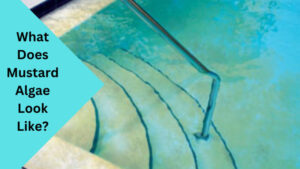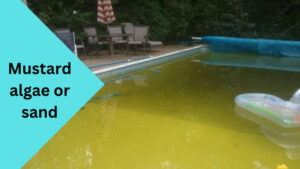Imagine relaxing by your sparkling pool on a warm summer day, only to discover an unwelcome guest invading the water. Mustard algae, also known as sand algae, can turn your pool into a cloudy, foul-smelling mess. But fear not! In comprehensive guide, we will unravel the mystery of mustard algae and equip you with the knowledge to identify, prevent, and treat this persistent pool problem. Whether you’re dealing with mustard algae or sand, our expert advice will help you restore your pool to its former crystal-clear glory.
- What is Mustard Algae?
- What Does Mustard Algae Look Like?
- Mustard Algae or Sand: How to Differentiate?
- The Dangers of Mustard Algae
- Causes of Mustard Algae Infestation
- Prevention Tips to Keep Mustard Algae at Bay
- Effective Treatment Methods for Mustard Algae
- Mustard Algae vs. Pollen: What’s the Difference?
- Conclusion
What is Mustard Algae?
Mustard algae, scientifically known as Phaeocystis globosa, is a common form of microscopic algae that can infest swimming pools, leaving behind a yellowish or mustard-like appearance. Unlike other types of algae, such as green or black algae, mustard algae are resistant to standard chlorine levels and require specific treatment methods. Mustard algae predominantly thrive in warm water with low sanitizer levels, making them a nuisance for pool owners in certain regions or during hot summer months.To explore more details and considerations regarding Mustard Algae, our comprehensive guide on A Complete Guide to Eradicate Mustard Algae: Say Goodbye to Pool Troubles has you covered.
What Does Mustard Algae Look Like?

Mustard algae initially appear as small patches or spots on pool surfaces, resembling sand or pollen. If left untreated, these patches can quickly multiply and spread throughout the pool, turning the water into a hazy, cloudy mess. The texture of mustard algae is slimy, making it easy to distinguish from sand particles. By understanding what mustard algae looks like, you can take swift action to combat its growth and prevent further infestations.
Mustard Algae or Sand: How to Differentiate?
Several pool owners confuse mustard algae with sand particles due to their similar appearance. While both may give off a yellowish hue, there are a few key differences to help you differentiate between the two. Sand particles are fine and gritty, often sinking to the bottom of the pool. On the other hand, mustard algae form in small clusters or spots and tend to float or suspend in the water. Additionally, sand will feel rough to the touch, whereas mustard algae is slimy. If you’re unsure whether you’re dealing with mustard algae or sand, the following symptoms can help you make a more accurate determination.
The Dangers of Mustard Algae
Mustard algae may not pose immediate health risks to swimmers, but they can compromise the overall pool experience and cause various problems if left untreated. Here are a few dangers associated with mustard algae infestations:
- Reduced Aesthetic Appeal: Mustard algae turn pool water cloudy and yellowish, making it uninviting and less visually appealing.
- Slippery Surfaces: The slimy texture of mustard algae can create slippery surfaces, increasing the risk of accidents and injuries.
- Clogged Filters: Mustard algae can accumulate in pool filters, obstructing water flow and reducing filtration efficiency.
- Increased Chemical Usage: Treating mustard algae usually requires higher chlorine or algaecide dosages, leading to increased chemical usage and costs.
- Contamination Risk: If left untreated, mustard algae can facilitate the growth of other harmful bacteria and pathogens, posing a potential health risk to swimmers.
Causes of Mustard Algae Infestation
Understanding the underlying causes of mustard algae infestations can help you take proactive measures to prevent their recurrence. Here are a few common factors that contribute to mustard algae growth:
- Inadequate Sanitizer Levels: Low chlorine or sanitizer levels create an ideal environment for mustard algae to thrive. Insufficient sanitization allows algae spores to multiply and form visible colonies.
- Warm Water Conditions: Mustard algae prefer warm water temperatures, typically ranging between 60°F and 86°F (15°C and 30°C). Such conditions are more prevalent during summer months or in regions with consistently high temperatures.
- Poor Filtration and Circulation: Insufficient filtration and poor water circulation enable algae spores to settle and multiply in stagnant areas of the pool, promoting mustard algae growth.
- Contamination from Unbalanced Pool Water: Imbalanced pool water with high pH or alkalinity levels, as well as inadequate calcium hardness, can create an environment conducive to algae growth, including mustard algae.
- Introduction from External Sources: Mustard algae can also enter the pool through contaminated equipment, bathing suits, or even untreated water sources.
Did you know : Is Pool Algae Harmful To Humans?
Prevention Tips to Keep Mustard Algae at Bay
Prevention is the key to keeping mustard algae at bay and maintaining a healthy and enjoyable swimming pool. By implementing these simple yet effective prevention tips, you can minimize the risk of mustard algae infestations:
- Regular Pool Maintenance: Establish a routine maintenance schedule, including proper circulation, regular skimming, and vacuuming to prevent debris accumulation and promote good water circulation.
- Maintain Appropriate Sanitizer Levels: Keep your pool’s sanitizer levels within recommended ranges to ensure effective algae prevention. Regularly test the water and adjust chemical levels accordingly.
- Optimize Filtration System: Clean and backwash your pool filter regularly to maintain optimal filtration performance. A well-functioning filtration system helps remove algae spores and prevents them from settling.
- Monitor and Balance Pool Water Chemistry: Regularly test and adjust pH, alkalinity, and calcium hardness levels to maintain a balanced pool environment that discourages algae growth.
- Properly Clean Pool Equipment: Thoroughly clean all pool equipment, including brushes, nets, and vacuum heads, after each use to prevent cross-contamination and the introduction of algae spores.
- Treat External Water Sources: If you refill your pool using an external water source, ensure that the water is properly treated and free from algae spores or contaminants.
Effective Treatment Methods for Mustard Algae
Occasionally, despite your best preventive efforts, mustard algae may still find its way into your pool. Swift and appropriate treatment is essential to eliminate these stubborn algae colonies. Here are effective treatment methods to combat mustard algae infestations:
Method 1: Shock and Brushing
- Test Your Pool Water: Begin by testing your pool water’s chlorine levels. Mustard algae may require chlorine levels higher than those needed for regular pool maintenance.
- Shock Treatment: Follow the manufacturer’s instructions and shock your pool with a suitable chlorine shock product to kill algae and break its resistance. Be sure to add enough shock to bring the chlorine levels above the recommended shock level.
- Brush the Affected Areas: Use a pool brush with stiff bristles to vigorously scrub the affected areas, including walls, steps, and corners. This mechanical action helps break the algae’s protective layer and allows the shock treatment to penetrate effectively.
- Run the Pool Filter: After shocking and brushing, operate your pool filter continuously for at least 24 to 48 hours to remove dead algae cells and debris.
- Repeat if Necessary: If mustard algae persists, repeat the shock treatment and brushing process until it is completely eradicated.
Method 2: Algaecides
- Choose the Right Algaecide: Select a reliable algaecide specifically formulated to target mustard algae. Read and follow the product instructions carefully.
- Adjust Water Chemistry: Test the pool water and adjust pH and alkalinity levels as needed to prepare the pool for algaecide treatment.
- Apply the Algaecide: Pour the recommended dosage of algaecide evenly around the edges of the pool, ensuring thorough coverage.
- Brush the Pool Surface: After applying the algaecide, brush the pool surface, focusing on areas with visible algae growth. This helps the algaecide penetrate and kill the algae more effectively.
- Allow for Circulation: Run the pool filter continuously for the required duration specified on the algaecide product label. Proper circulation ensures even distribution of the algaecide throughout the pool.
- Monitor and Repeat: Regularly monitor the pool for any signs of recurring mustard algae. If necessary, repeat the algaecide treatment to fully eliminate the infestation.
Method 3: Super Chlorination
- Test and Balance Water Chemistry: Test the pool water and ensure that the pH and alkalinity levels are within the recommended range for super chlorination.
- Prepare the Pool: Activate the pool’s circulation system and remove any debris or visible algae growth by skimming, vacuuming, or brushing.
- Chlorine Super-Chlorination: Follow the recommended dosage guidelines and add a sufficient amount of chlorine to raise the free chlorine levels higher than normal. This shock treatment helps destroy mustard algae and other contaminants.
- Allow Sufficient Contact Time: Let the super chlorinated water circulate for several hours while the chlorine works to kill the algae. Keep the pool uncovered during this process for better aeration.
- Monitor and Balance: Regularly test the pool water during and after super chlorination. Adjust the chlorine and chemical levels as needed to ensure a safe and balanced swimming environment.
For Full Depth Details check out our lates article about How to Get Rid of Algae Dust in a Pool
Method 4: Filter Cleaning
- Turn Off the Pool Pump: Ensure the pool pump is turned off before beginning the filter cleaning process.
- Backwash the Filter: If your pool has a sand or DE (diatomaceous earth) filter, follow the manufacturer’s instructions to backwash the filter thoroughly. This process helps remove trapped algae and debris.
- Clean or Replace the Filter Cartridge: For cartridge filters, remove the cartridge and rinse it with a hose. If necessary, soak the cartridge in a filter cleaner solution to remove stubborn algae deposits. Consider replacing the cartridge if it is damaged or excessively dirty.
- Rinse and Reinstall: After cleaning or replacing the filter element, rinse it with clean water to remove any remaining debris. Reinstall the filter cartridge or complete the backwashing process according to the manufacturer’s instructions.
- Maintain Regular Filter Maintenance: To prevent further algae infestations, establish a regular filter cleaning schedule and follow the manufacturer’s recommendations. Regular maintenance ensures optimal filter performance.
Did you know Ultimate Guide to Hot Tub Stains
Mustard Algae vs. Pollen: What’s the Difference?
It’s not uncommon for pool owners to mistake mustard algae for pollen due to their similar appearance. While mustard algae can often appear sand-like, pollen is an entirely different substance. Here’s how you can differentiate between mustard algae and pollen:
- Appearance: Mustard algae form in clusters or patches, giving the pool water a yellowish or mustard-like coloration. Pollen, on the other hand, appears as small, distinct particles that typically float on the pool’s surface.
- Texture: Mustard algae have a slimy texture compared to the fine, powdery feel of pollen particles.
- Persistence: Mustard algae tend to cling to pool surfaces and require specific treatment methods for eradication. Pollen, however, can be easily removed through pool filtration or skimming.
- Seasonality: Pollen is typically more prevalent during spring and early summer when plants release their pollen. Mustard algae, on the other hand, can occur throughout the year, especially in warmer climates where water temperatures favor their growth.
Understanding the difference between mustard algae and pollen enables you to apply the appropriate treatment methods and maintain a clean, pollen-free pool environment.
Conclusion
Now that you’re armed with in-depth knowledge about mustard algae and its treatment, prevention, and differentiation from other substances like sand or pollen, you can confidently tackle the challenges it presents. Remember to maintain proper pool maintenance, balance water chemistry, and promptly address any signs of mustard algae to prevent infestations and keep your pool water crystal-clear. By implementing our expert tips and treatment methods, you’ll soon bid farewell to mustard algae, ensuring a delightful and refreshing swimming experience all year round.

Greetings, fellow pool enthusiasts! I’m Turner Davis, your dedicated guide to the world of pool care and maintenance. With over a decade of experience in the field, I’ve made it my mission to transform ordinary pools into extraordinary aquatic retreats.

